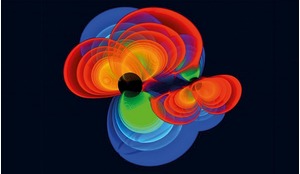The potential for the extraction of helium-3 from the Moon’s surface and its use as a fuel for Earth-based fusion reactors has been well-publicised. Here, the authors present the scientific basis of the extraction process by means of thermodynamic heating of the lunar regolith, exposure to resonant electromagnetic radiation and active oxidation by microorganisms. They also explain how the total amount of lunar helium-3 can be estimated more accurately and how the promise of carbon-free thermonuclear energy may be realised in the future.
Methods of extraction and processing of minerals on the Earth are widely known and described in numerous scientific publications. However, their applicability to lunar conditions, and in particular to the extraction of helium-3 (helion) from regolith, requires further scientific research. This research is interesting because helium-3, which is much more abundant on the Moon than on Earth, is considered the most promising component of thermonuclear reactors of the future - the basis of carbon-free energy.
Helium-3 content
Studies of helion content in samples delivered by the Soviet Luna-16, -20 and -24 spacecraft, and by American astronauts, showed that it was about 7.43×10-5 m3/tonne; in terms of physical chemistry, this is known as the sorption capacity of the regolith with respect to helion. The solar wind not only adsorbs helion onto the surface of the regolith, but also diffuses it into its crystal lattice, processes which have taken place throughout the Moon’s existence.
The helion pressure on the Moon’s surface is estimated using the formula:
P = 1.6726 x 10-6 n V2 (1)
where P is pressure [nPa], n is particle density [cm-3] and V is particle velocity [km/s].
Helium-3, which is much more abundant on the Moon than on Earth, is considered the most promising component of thermonuclear reactors of the future
Taking into account that n = 15 x 10-5 cm-3 and v = 1000 km/s, we get P = 0.025 nPa (2.5 x 10-11 Pa). At such low pressures, not exceeding 0.1 MPa, the adsorption process of gases is well described by the Henry isotherm, which is written as follows:
a = c P (2)
where c is Henry’s constant, which for the process of helion adsorption on the lunar regolith is equal to 3 x 106 m3/t/Pa.
A knowledge of this value will not only provide a more accurate estimate of the total amount of helion on the Moon for the practical purposes of future mining of minerals, but will also help to identify the need for machinery and equipment to process regolith, extract helium-3 and deliver it back to Earth.
Regolith processing
From the authors’ point of view, the volcanic hypothesis for regolith formation is the most productive and our views are based on the simple assumption that lunar regolith and volcanic ash are probably identical concepts [see Table 1].
The comparative data presented in the table allow us, without denying other hypotheses, to suggest that volcanic processes, which are believed to have ended 3-3.5 billion years ago, were the main source of regolith. During this time interval, the helion atoms in the solar wind had time to adsorb onto the fallen regolith.
In order to extract the helion adsorbed in the regolith, the regolith must first be isolated from the solar wind stream by placing it in a special sealed vacuum vessel, and then subjected to one of the known processing effects. There are three main types of processing: thermodynamic heating, application of a resonant electromagnetic field and microbiological transformation of regolith macrostructure.
Thermodynamic processing
In order to extract the helion adsorbed in the regolith, the regolith must first be isolated from the solar wind stream by placing it in a special sealed vacuum vessel
The scientific basis for thermodynamic heating is the theory of adsorption. The following formula is the basic equation for the theory of micropore volume filling (TMVF):
a = aoexp[-(A/E) n] (3)
where a is the sorption value corresponding to a certain saturation pressure; ao is the limit value of sorption; A is the differential molar work; E is the characteristic energy equal to the differential molar work of sorption at the characteristic point of isotherm (where a = 0.368 ao); and n is the structural parameter of sorbent.
This equation shows that the characteristic energy (E) also predetermines the value of adsorbed gas, which determines how helion is absorbed in the regolith, according to the following expression:
E = nR T / β (4)
where β is the energy parameter, whose value is inversely proportional to temperature.
Experiments have shown that the characteristic energy is proportional to the square of the temperature at which the forward and reverse adsorption process takes place. This is a very strong dependence: for example, for the desorption of methane from natural coal, an increase in temperature by 70C leads to a decrease in the sorption capacity of coal by 10-15 percent - in other words, an increase in the degree of methane recovery from coal matter.
The physical reason for this process is the fact that the heat energy absorbed by adsorbed molecules first activates their vibrational and then their translational degrees of freedom, which makes them mobile and able to detach from the sorbent surface. The helion extraction process from regolith is carried out with a device, a possible layout of which is shown in graphic opposite.
Electromagnetic processing
A second option for regolith processing is the application of a resonant electromagnetic field, the scientific basis for which is the theory of structural transformation of gas-saturated coal matter under various types of external effects developed at the Research Institute of Comprehensive Exploitation of Mineral Resources (RAS RICEMR).
There are three main types of processing: thermodynamic heating, application of a resonant electromagnetic field and microbiological transformation of regolith macrostructure
It involves the destruction of gas-saturated rocks by external electromagnetic influence using the natural resonance characteristics of the rock’s structure. The method makes it possible to form transport channels in the rock, through which 80 percent of the absorbed gas is converted to a free state (i.e. released), an effect which has been confirmed experimentally.
The required equipment includes broadband electromagnetic radiation (EMR) generators, providing sinusoidal radiation in the frequency range from 20 Hz to 50 MHz with an amplitude of 1.0 to 5.0 V. It consumes a power of no more than 0.5 kW at the radiator and no less than 0.1 kW at an efficiency of 85 percent. In hardware terms, it includes a remote substance polarisation indicator, a recorder of the outgassing effects during electromagnetic action on a sorbent sample (coal in this particular experiment) and a vacuum decryptograph with a chromatographic attachment.
Results of the irradiation of 200 g of pre-degassed and vacuum degassed coal are shown in the figure below. Analysis of the results shows, in the first sample, only two maxima of gas release at frequencies of 50 and 500 kHz, and in the second sample two maxima at the same frequencies 50 and 500 kHz and two additional maxima at 5 and 50 MHz.
Thus, the electromagnetic effect was experimentally confirmed for both samples: i.e., the transformation of the micro- and macrostructure of the sorbent, which allowed the gas within to pass from the adsorbed state to the free state, was confirmed.
The practical value of the possibility of this processing method for the extraction of helion is that it will reduce the energy costs of implementing the process several times compared with the thermal heating method.
Microbiological processing
Another promising method of extracting helion from regolith could be to extract it using microorganisms. Experiments have shown that not only can microorganisms survive in reduced gravity, deep vacuum and harsh ultraviolet light, such as that found on the Moon, but also that they can do useful work.
This property of microorganisms has been proven more than once during experiments on the International Space Station (ISS). Conducted between October 2014 and June 2016 under the BIOMEX programme (the simulation of Martian or lunar soil conditions), they involved installing a container with capsules containing microbes and algae sampled from lifeless places on Earth on the outside of the Russian Zarya module. It was convincingly confirmed that terrestrial microorganisms not only survived in outer space, but also retained high biological activity, with the aggressive properties of microorganisms increasing under the influence of solar radiation.
Experiments have shown that not only can microorganisms survive in reduced gravity, deep vacuum and harsh ultraviolet light, such as that found on the Moon, but also that they can do useful work
Further works in this direction, which can be called the ‘microbiological fertilisation of soils and rocks of waterless planets with lower gravity’, should take into account that microorganisms are characterised by unusual multiplicity, variety of forms, prevalence in any physical conditions, and exhibit a multiplicity of interaction with the environment and influence on it.
It should also be kept in mind that microorganisms behave as if they had a definite purpose, aimed at the fulfilment of a predetermined plan, which in this case involved the formation of two cells from one (division) at the highest possible rate. Thirdly, we should remember that microorganisms are capable of degrading the most diverse chemical compounds in accordance with the principle of ‘microbial omnivorousness’ formulated by the English scientist Ernest Gale, who claims that microorganisms are capable, under suitable conditions, of oxidising any substance theoretically capable of oxidation.
It is these properties of microorganisms that provide the fundamental basis for the development of microbial mineral processing methods, leading to the damage of bulk soils and rocks with the release of a useful component, including helion.
Conclusions
With regard to the potential for the extraction of helium-3 from the lunar regolith, our research has shown that knowledge of the value of the Henry constant for the helion adsorption isotherm is of practical importance, because it makes it possible to estimate more accurately the total amount of helion on the Moon and to design regolith processing facilities for its extraction.
Technologies of helion extraction using thermodynamic heating, resonant electromagnetic radiation and active oxidation by microorganisms are promising and offer effective and practical techniques that may be used in the future. In particular, studies of microbial transformation of regolith have been shown to be of great practical significance, as they allow the prediction of microbial behaviour in the creation of life support systems for space flights, permanent settlements on the planets and methods for mining minerals there.
About the authors
Vyacheslav A Bobin is a Chief Researcher at the Academician N Melnikov Institute of Mineral Wealth Integrated Development of the Russian Academy of Sciences. He is an Academician A Skochinsky award holder, recipient of the Russian Government Prize in Science and Engineering and holds 19 patents. He is also the author of more than 200 academic papers and eight monographs (including ‘Gyroscopic Mining Machinery for Extracting Earth and Lunar Minerals’ co-authored with Anna Bobin).
Anna V Bobin has a PhD in engineering and is Division Director for Academic Conferences and Russia-wide Projects at the Russian Free Economic Society. She is also a member of the editorial board of the ‘Russian Free Economic Society Tractates’ journal, the author of 12 academic papers and holds three patents.














